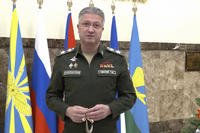UPDATED: Gates Says His "Every Day" Devoted to Fixing Pentagon; Mullen Says Services Support Reforms
Defense Secretary Robert Gates put it clearly earlier this month at the Eisenhower Luncheon, “it’s a simple matter of math.” While it would be the prudent way to go to keep the force structure at current levels, being that we are a nation in a pair of wars, he said, there is the problem of budgetary realities. “It is highly unlikely that we will achieve the real growth rates necessary to sustain the current force structure.”
At a news conference this afternoon, Gates made clear his commitment: “I intend to spend every day, for as long as I remain secretary of defense, doing all I can to implement these reforms that are so critical to sustaining our military in the years ahead.”
Gates has the full support of the uniformed military in the building, the chairman of the Joint Chiefs of Staff said at the news conference.
“The proper stewardship of the taxpayers’ dollars is high on absolutely everybody’s list,” Navy Adm. Mike Mullen said. “I don’t underestimate the challenge that is here. But I think being able to get at overhead and shift it … and do so inside the force structure that we have right now is absolutely critical.”
To pay troops and to buy new weapons, savings must be found inside the defense budget, Gates said at his earlier speech: cut overhead costs, which typically means redundant management; to convert unneeded tail to tooth.
But Pentagon sources tell DoD Buzz that planners aren’t just looking at cutting tail; serious cuts in tooth are also being considered. Specifically,senior Pentagon leaders may cut Army and Marine force levels back to where they were before Gates boosted the land forces in early 2007 by 92,000; 65,000 additional soldiers and 27,000 more Marines.
The plan would be to slowly ramp down the boots starting by fiscal year 2014, eventually getting the Marines back to 180,000 total and the Army to 482,000. That plan is, of course, contingent on the continued withdrawal of troops from Iraq and at least some reduction in Afghanistan troop levels.
Such reflects the thinking among some Pentagon strategists that the counterinsurgency wars in Iraq and Afghanistan have swung the military far from its traditional way of fighting, which is to rely on firepower and standoff strike to dispatch foes, rather than engage in the nasty close quarters combat where American high-tech advantages are nullified.
The techno-centric revolution in military affairs crowd, whose ideas were largely discredited on Iraq’s urban battlefields, is making something of a comeback, said one source. The Navy and Air Force had been making progress in that direction, and actually prevailed in the 2006 QDR, then Gates took over at the Pentagon and began to direct the institution to focus on the current wars and irregular warfare write large.
Irregular warfare is not going away by any stretch, strategists realize, however it will become more the purview of special operations forces; the “indirect approach” as its called. The idea is to use small advisory teams training foreign militaries to battle terrorist networks and insurgencies instead of sending in an army of occupation.
A subtle nudging back towards the RMA way of thinking can be seen in the recent work of influential defense think tanks. Earlier this week, the Center for Strategic and Budgetary Assessments released their blueprint for an AirSea Battle concept intended to counter a rapidly modernizing Chinese military that threatens to replace the U.S. as the dominant military power in the Western Pacific.
CSBA’s AirSea Battle concept, which got the jump on a similar conceptual exercise by the same name underway in the Pentagon, aims to sustain a military balance favorable to the U.S. That will require more than innovative ideas on employing naval and air power, said the outfit’s president, Andrew Krepinevich, in fact the CSBA report contains some pretty major force structure changes and a substantial reordering of the program of record, including major investments in sensors, long-range precision strike, new bombers and aerial drones.
Of course the question of how to pay for that is a big one. CSBA proposes savings through force structure cuts. “The savings from a reduction of one hundred thousand or more active-duty soldiers and marines would result in considerable savings in personnel and operations and maintenance costs, as well as lower equipment procurement requirements for reduced maneuver units,” the report says.








